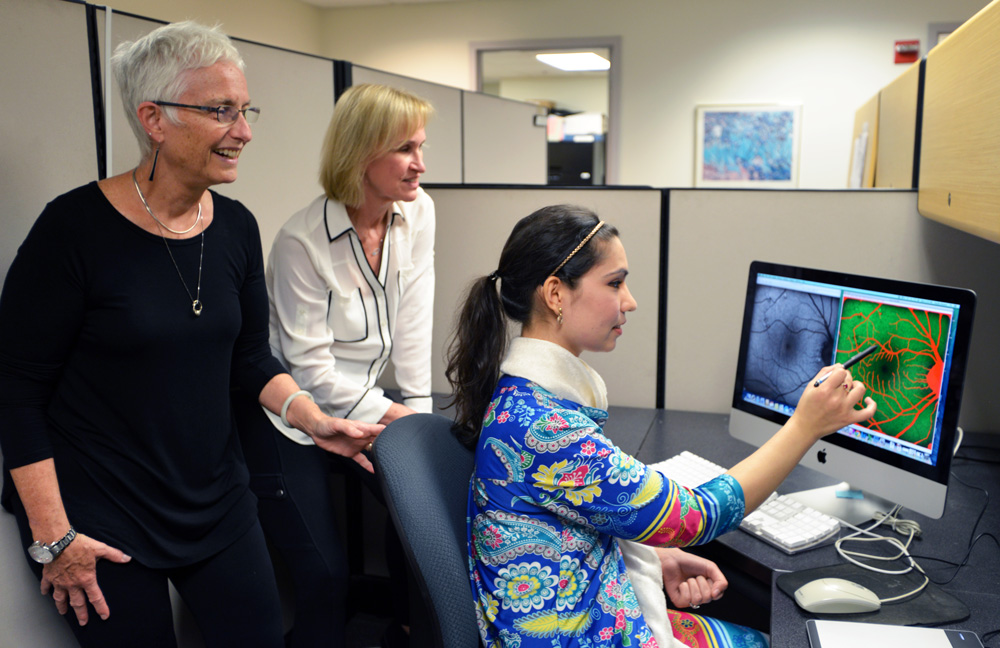 Fazila Aseem (seated) with UAB Ophthalmology faculty members Christine A. Curcio, Ph.D. (far Left), and Cynthia Owsley, Ph.D.As a young girl in Afghanistan, Fazila Aseem watched her grandmother struggle to complete daily tasks independently due to vision loss. Her grandmother was unable to see well enough to prepare a simple meal for herself, and there was nothing Afghan doctors could do to restore or repair her vision.
Fazila Aseem (seated) with UAB Ophthalmology faculty members Christine A. Curcio, Ph.D. (far Left), and Cynthia Owsley, Ph.D.As a young girl in Afghanistan, Fazila Aseem watched her grandmother struggle to complete daily tasks independently due to vision loss. Her grandmother was unable to see well enough to prepare a simple meal for herself, and there was nothing Afghan doctors could do to restore or repair her vision.Then, many years later a simple cataract surgery improved her grandmother’s vision and quality of life significantly. Aseem wondered how many other older adults faced a similar struggle, suffering from a curable condition because of treatment and care deficits.
This experience sparked a thirst for knowledge and Aseem’s desire to improve treatment and care for older adults. This summer, through a fellowship from the American Federation in Aging Research, Aseem will work with researchers in the UAB Department of Ophthalmology to continue her interest in aging and vision research.
“Ophthalmology provides me with the ability to combine my interest in science with my humanitarian vision to make a positive impact in the lives of disadvantaged people, including older adults,” said Aseem. “In the future, I would like to be involved in both clinical practice as well as research so I can not only provide care but also help improve treatment options for vision impairments.”
Aseem, a medical student at Wake Forest University, will work with ophthalmology faculty members Christine A. Curcio, Ph.D., and Cynthia Owsley, Ph.D., and the Alabama Study on Early Age-Related Macular Degeneration (ALSTAR), funded by the National Institute on Aging of the National Institutes of Health. This study aims to uncover risk factors that make certain older adults more susceptible to age-related macular degeneration (AMD), a disease that causes central vision loss for millions of Americans.
“I want to continue my work with the ALSTAR project because it provides the unique opportunity to study the subcellular basis of clinical autofluorescence imaging and functional assays of transitioning from normal aging to AMD under the supervision of two brilliant scientists in the field—Drs. Curcio and Owsley,” Aseem said. “I am also excited about the prospect of setting a potential diagnostic biomarker for the earliest emergence of AMD, so AMD patients are able to seek early care.”
Although treatment for AMD is available, it cannot begin until the later stages of the disease, when vision loss is extensive. Through the ALSTAR Study and other lines of research, UAB Ophthalmology is focusing on understanding the earliest stages of AMD, hopeful that this work will lead to the next generation of treatments and, ideally, a way to prevent this devastating disease.
“Autofluorescence is a superb way to monitor the retinal cells most affected by AMD. Fazila’s project will help us detect the very earliest stages of degeneration in ALSTAR study patients,” Curcio said. “Due to their participation in the ALSTAR study, these patients' vision, health, and lifestyle are now well documented. The addition of autofluorescence imaging will lead us to biomarkers for the emergence of AMD.”